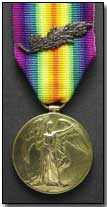Encyclopedia - Inter-Allied Victory Medal
 The Inter-Allied Victory
Medal (generally referred to simply as the Victory Medal or as the Allied
War Medal) was instituted following an agreement by fourteen Allied powers
in March 1919.
The Inter-Allied Victory
Medal (generally referred to simply as the Victory Medal or as the Allied
War Medal) was instituted following an agreement by fourteen Allied powers
in March 1919.
Intended as a means of providing for a single medal across each of the Allies (removing the need for an exchange of Allied medals, although individual nations issued medals with slight variations), the medal was made from yellow bronze and was 36mm in diameter. The ribbon was officially described as "two rainbows with red in the centre".
The obverse of the medal depicted the winged figure of Victory with her left arm extended while her right held a palm branch. The reverse of the medal contained the legend The Great / War For / Civilization / 1914-1919 across four lines, surrounded by a wreath.
The medal was awarded to all those who had served in the armed forces, as well as to civilians contracted to the armed services, and to those who served in military hospitals on the various battlefronts during wartime. Members of the British Naval Mission to Russia during 1919-20 and men involved in North Sea mine clearance operations were similarly eligible for the medal.
In Britain (and among her colonies and dominions) the Victory Medal was always awarded in concert with another medal, usually the 1914 Star or 1914-15 Star or British War Medal.
No additional Bar was available to accompany the Victory Medal, although men Mentioned-in-Despatches wore an oak-leaf emblem along with the medal.
Around one million Indian troops served in WW1, of which some 100,000 were either killed or wounded.
- Did you know?
